

My Place for teachers. In May 1787 the First Fleet, commanded by Captain Arthur Phillip (1738–1814), left Portsmouth in England with six convict transports, three store ships and two navy vessels, including the flagship HMS Sirius.
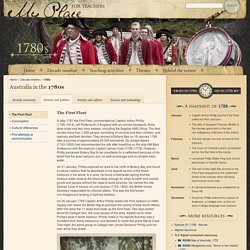
The fleet carried more than 1,300 people, consisting of convicts and their children, and marines and their families. They arrived at Botany Bay on 18 January 1788 after a journey of approximately 20,000 kilometres. Sir Joseph Banks (1743–1820) had recommended the site after travelling on the ship HM Bark Endeavour with the explorer Captain James Cook (1728–1779). However, Phillip perceived Botany Bay to be unsuitable for a settlement because of his belief that the area had poor soil, no safe anchorage and no reliable fresh water. First Fleet - Classroom - BTN. Kid 1: "My name is John Hudson and I'm nine years old.
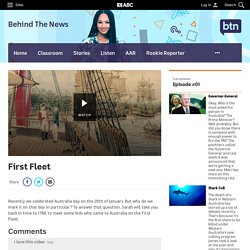
I've been an orphan ever since I can remember and I made a living sweeping chimneys. It was horrible work, dangerous too. In the summertime there's no need for sweeping so I took to thieving to survive. " Kid 2: "For the theft of one linen shirt, value 10 shillings, five silk stockings, value 5 shillings, one pistol, value 5 shillings, and two aprons, value 2 shillings. You are found guilty! " First Fleet. Onboard were 1420 people: 722 convicts including 17 child convicts, the soldiers who were to guard them, soldiers' wives, sailors, and ship's officers.
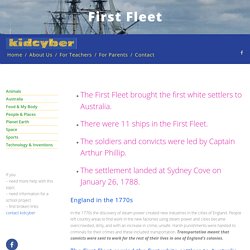
Although most of the convicts were English, there were also African, American and French convicts. 1788. The Founding of Australia.
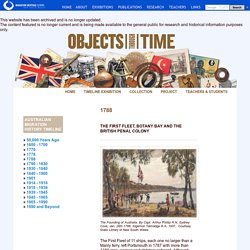
By Capt. Arthur Phillip R.N. Aboriginal places of significance. Aboriginal people have lived in the area known as New South Wales for at least 45,000 years.
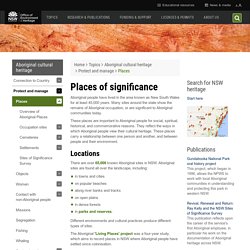
Many sites around the state show the remains of Aboriginal occupation, or are significant to Aboriginal communities today. These places are important to Aboriginal people for social, spiritual, historical, and commemorative reasons. They reflect the ways in which Aboriginal people view their cultural heritage. These places carry a relationship between one person and another, and between people and their environment. Locations There are over 65,000 known Aboriginal sites in NSW. In towns and citieson popular beaches along river banks and tracks on open plains in dense forestsin parks and reserves. Different environments and cultural practices produce different types of sites. The Aboriginal 'Living Places' project was a four-year study, which aims to record places in NSW where Aboriginal people have settled since colonisation.
Types of sites They can include: natural sacred sitesmassacre sites Protection. The 11 Most Sacred Places in Indigenous Australian Folklore. The 7.7 million square kilometres of the Australian continent have been home to 600 Aboriginal and Torres Strait Islander nations over the past 60,000 years, meaning the territory is covered with places that carry enormous significance in Indigenous folklore. Here are 11 of the most important. Uluru ‘The Rock’ is without doubt the most sacred site in Aboriginal folklore.
So sacred, in fact, that the government is banning visitors from climbing Uluru as of October next year. Understanding the Spiritual Value of Uluru » 7travel » 7travel. The Anangu people of Uluru have lived there for thousands of years and they are still the traditional landowners today.
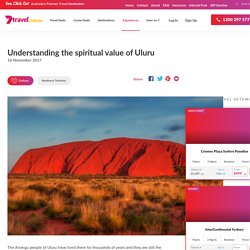
To honour their heritage and culture, visitors to this site share the responsibility of preservation and protection. But to do so, it’s important to understand the spiritual significance of this land to the Anangu - and the entire country - and how to show respect. Uluru-Kata Tjuta National Park is recognised by UNESCO in two ways: for its geological formations and rare plants and animals, as well as for its cultural importance.
Uluru-Kata Tjuta National Park - Overview - World Heritage Places. The immense rock formation of Uluru and rock domes of Kata Tjuta are remarkable geological and landform features set on a sand plain.
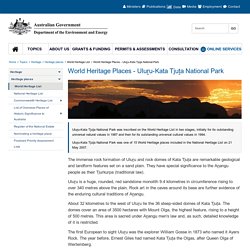
They have special significance to the Anangu people as their Tjurkurpa (traditional law). Uluru is a huge, rounded, red sandstone monolith 9.4 kilometres in circumference rising to over 340 metres above the plain. Rock art in the caves around its base are further evidence of the enduring cultural traditions of Anangu. About 32 kilometres to the west of Uluru lie the 36 steep-sided domes of Kata Tjuta.
The domes cover an area of 3500 hectares with Mount Olga, the highest feature, rising to a height of 500 metres. Uluru Climbing Ban - Classroom - BTN. PAUL HOGAN: You look like you need a holiday, a fair dinkum holiday.
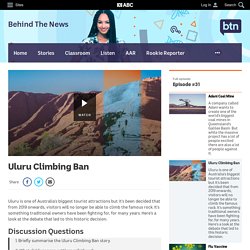
In a land of wonder, the land down under. For a long time, this big red rock has been right at the heart of Aussie tourism. But the way we've seen Uluru has changed a lot over the years. Up until the mid-80s it was actually known as Ayres rock to most people. It was named after the Premier of South Australia by explorers who came across it in the 1800's. We'll close Uluru: Indigenous community. This story was published in 2016.
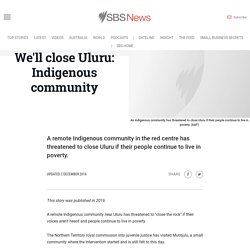
A remote Indigenous community near Uluru has threatened to "close the rock" if their voices aren't heard and people continue to live in poverty. The Northern Territory royal commission into juvenile justice has visited Mutitjulu, a small community where the Intervention started and is still felt to this day. Uluru-Kata Tjuta National Park. Named after Mutitjulu Waterhole, Mutitjulu community is home to Anangu who live within the park.
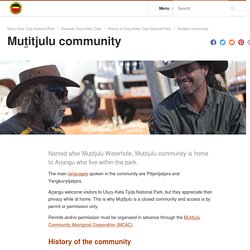
The main languages spoken in the community are Pitjantjatjara and Yangkunytjatjara. Anangu welcome visitors to Uluru-Kata Tjuta National Park, but they appreciate their privacy while at home. This is why Mutitjulu is a closed community and access is by permit or permission only. Mutitjulu community. The Ininti Store is a focal point for Anangu art and enterprise since its opening in July 1972. The Docker River Social Club set up the Ininti Store at a site that is now Mutitjulu (the Anangu community), within the Park. A Northern Territory press release dated 8 September 1972 lauded the success of the venture. Uluru - Australia.
Uluru in Aboriginal Culture - History and Legends. Uluru is more than just a rock, it is a living cultural landscape that of which is considered sacred to the Yankunytjatjara and Pitjantjatjara people. These people of the land are the traditional owners and guardians of the Uluru-Kata Tjuta National Park. This special place carries great spiritual and cultural significance for these local indigenous tribes with over 40 sacred aboriginal sites and eleven Tjurkurpa or Dreaming trails present in the area. Understanding Welcome to Country. Although the practice of acknowledging the Traditional Custodians of land and seeking their permission to enter their territory has only recently begun to re-emerge in modern Australia, it's an ancient custom of great significance to many Indigenous people. While some people may see Acknowledgement and Welcome to Country as recent practices invented for the sake of political correctness, or an empty token gesture, Wurundjeri Elder, Joy Murphy Wandin, describes it as: “a very important way of giving Aboriginal people back their place in society, and an opportunity for us to say, 'We are real, we are here, and today we welcome you to our land'…It's paying respect, in a formal sense, and following traditional custom in a symbolic way.” [1]
What is the 'Dreamtime' or the 'Dreaming'? English cannot express the 'Dreaming' 'Dreamtime' or 'Dreaming' has never been a direct translation of an Aboriginal word. Aboriginal Flag History - Classroom - BTN. □□ Burning to save Australia's Western Desert - earthrise (feature)